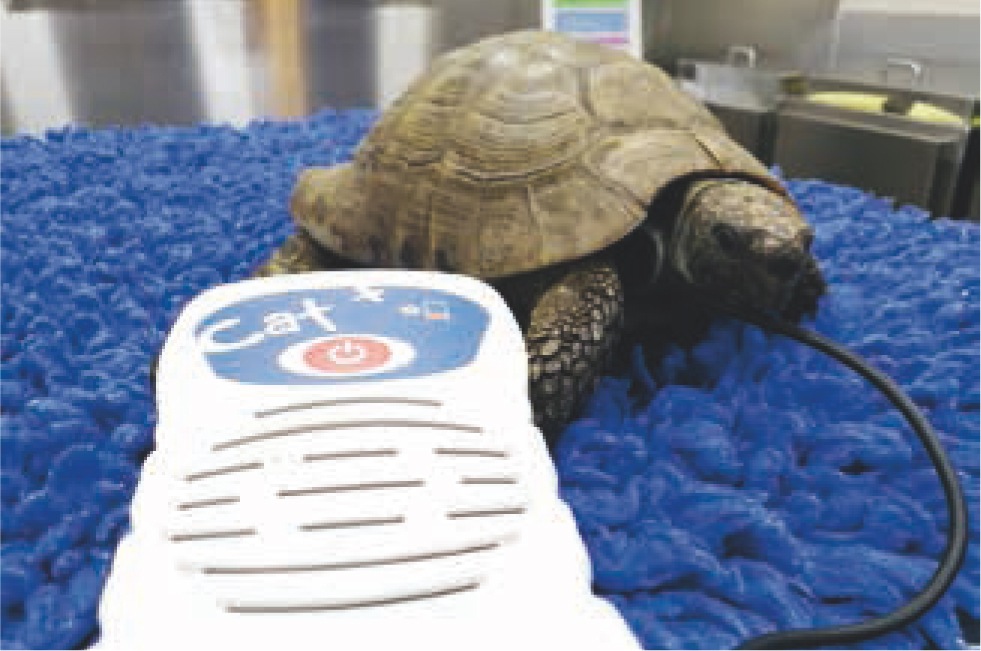Confirming death or otherwise in chelonia can be difficult. Th is short article discusses the problems faced and suggests solutions to them, as well as providing information on euthanasia in these shelled reptiles
Metabolism
Tortoises are reptiles and ectotherms, that is their body temperature and metabolic rate are dependent on the temperature of their environment. If kept in cold environments, their metabolic rate will drop and they can seem to be apparently lifeless. In addition, some tortoise species (in particular the Mediterranean Testudo spp.) have the ability to hibernate and drop their metabolic rate during periods of cold weather. Tortoises examined during or just after hibernation may appear to be inactive and sometimes lifeless. In addition, tortoises appear to be extremely tolerant of periods of hypoxia and can survive situations in which mammals would not be expected to live (eg prolonged submersion underwater, such as if they fall into a garden pond).
Reptiles’ slow metabolic rate and resistance to hypoxia can make death confirmation and indeed euthanasia challenging (Baines and Davies, 2004a; Cooper, 2019; Nevarez, 2019; American Veterinary Medical Association, 2020).
Anatomy
To add to the troubles in assessing for signs of life, tortoises present some difficulties in clinical examination because of their peculiar anatomy. Th eir shell precludes easy auscultation of the heart and lungs, and indeed palpation of coelomic organs. Reflexes, such as the palpebral, corneal and pedal withdrawal reflexes, may be reduced with lower ambient temperatures, and may be poorly evident in some individuals. Many veterinary professionals may also not be familiar with clinical examination and normal behaviour of chelonian patients.
Signs and tests
So, how can we tell if a tortoise has died? Sometimes it is obvious – the body exhibits rigour mortis or overt decomposition – but off en further checks are needed. Dead tortoises will show total immobility, an absence of spontaneous breathing and an open larynx, but the heart may continue to beat after death (ie after the absence of brain activity), making confirmation of death difficult. Pedal withdrawal, palpebral, corneal and cloacal reflexes may be tested, although negative findings do not necessarily indicate death.
Performing an electrocardiogram (ECG) can be useful, although weak signals may not be picked up by standard veterinary equipment. Also, ECG signals may be detected for up to 24 hours after apparent death as a result of ventricular pacing. When performing an ECG, the cranial lead is placed on the axillary skin folds while the caudal and neutral leads are placed on the skin folds caudal to the hindlimbs.
As shown in Figure 1, an 8 MHz Doppler probe, such as those used to measure feline blood pressure, can be used to check for a carotid pulse. The probe can be placed on the lateral neck and moved until a pulse is found. It should be remembered that reptilian heart rates will be much slower than those of mammals, and will also be temperature dependent. An ultrasound probe can also be used in the fossa between the lateral neck and the forelimb to try and visualise whether the heart is beating. If the fossa is too small to allow probe contact, an acoustic standoff may be used (for example an inflated glove filled with water).

Death may be confirmed by the lack of all withdrawal and ocular reflexes, no ECG trace and the use of 8 MHz Doppler or ultrasonography to show no heart beat (Baines and Davies, 2004b; McArthur et al, 2004; Mader, 2006; Chitty and Raftery, 2013; Hyndman, 2018).
If there is any doubt as to death, the tortoise should be kept somewhere warm (eg 24–30°C) for 24 hours before considering cremation or burial. To be completely sure, the tortoise may be pithed before disposal of the body, that is the brain mechanically disrupted using a needle or dental elevator. This can be done either through the roof of the mouth (more cosmetically palatable if the body is to be taken home by the owner) or through the foramen magnum.
Euthanasia
The next question we are offen asked is how to perform euthanasia humanely in tortoises (usually these are tortoises presenting as moribund, for example with extensive shell ecchymoses suggestive of septicaemia, and who may have initially appeared ‘dead’).
Freezing is not considered an acceptable method of euthanasia in reptiles (Baines and Davies, 2004a,b; American Veterinary Medical Association, 2020). Euthanasia is generally performed by intravenous injection of pentobarbitone (200 mg/kg) (McArthur et al, 2004). Prior sedation, for example with intramuscular ketamine, or intravenous or intramuscular alfaxalone, is strongly recommended, such that the tortoise becomes insensible. The tortoise should be kept warm during this period. Once anaesthetised, pentobarbitone may be given intravenously usually via the dorsal tail vein, jugular vein or subcarapacial venous sinus. Where intravenous access is not possible, for example in small juvenile tortoises, intracardiac injection through the plastron where the scutes intersect in the mid-line, after sedation, may be used, or alternatively using a longer needle introduced parallel to the neck and directed towards the midline. Intracoelomic injection is not recommended as uptake can be unpredictable and is likely to be painful (McArthur et al, 2004; Chitty and Raftery, 2013). After this, the brain should be pithed as discussed earlier.
So, ‘how do I know if this tortoise is dead?’ is not a silly question at all!
Key Points
- Confirming death in tortoises can be surprisingly difficult, because of their slow metabolic rate and resistance to hypoxia, plus some species’ ability to hibernate.
- A lack of familiarity with chelonian patients and their anatomical peculiarities may compound the challenge for some veterinary professionals.
- Death may be confirmed by the lack of all withdrawal and ocular reflexes, no electrocardiogram trace and the use of 8 MHz Doppler or ultrasonography to show no heart beat.
- Euthanasia in tortoises is generally performed by intravenous or intracardiac injection of pentobarbitone after sedation or anaesthesia. Reptiles should be pithed before burial or cremation.

